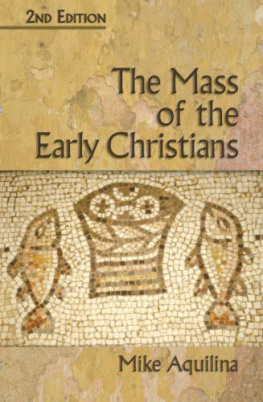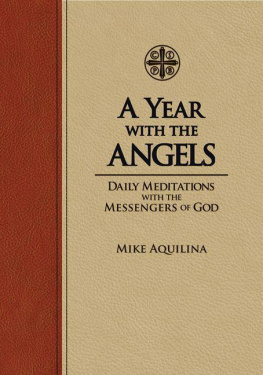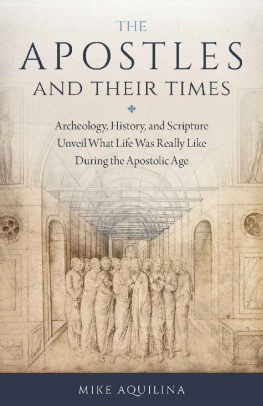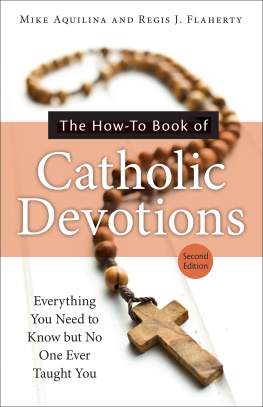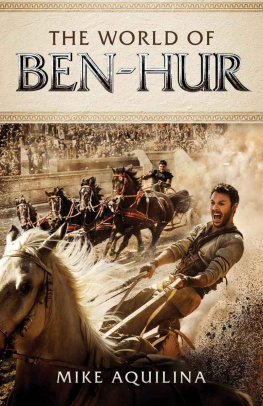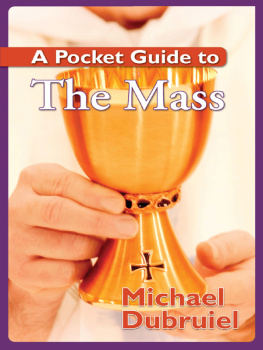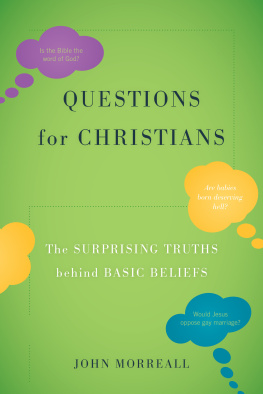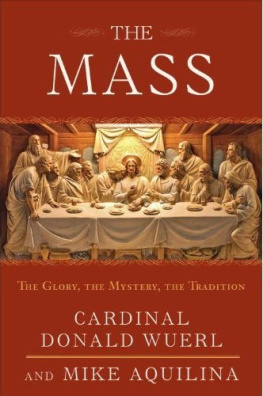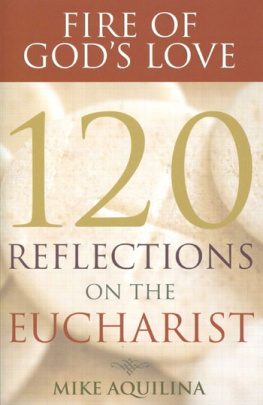2ND EDITION
The Mass of the Early Christians
2ND EDITION
The Mass of the Early Christians
Mike Aquilina
Our Sunday Visitor Publishing Division
Our Sunday Visitor, Inc.
Huntington, Indiana 46750
Most of the the Scripture citations used in this work are taken from the Catholic Edition of the Revised Standard Version of the Bible (RSV), copyright 1965 and 1966 by the Division of Christian Education of the National Council of the Churches of Christ in the United States of America. Used by permission. All rights reserved.
Every reasonable effort has been made to determine copyright holders of excerpted materials and to secure permissions as needed. If any copyrighted materials have been inadvertently used in this work without proper credit being given in one form or another, please notify Our Sunday Visitor in writing so that future printings of this work may be corrected accordingly.
Copyright 2001, 2007 by
Our Sunday Visitor Publishing Division
14 13 12 11 3 4 5 6 7 8 9
All rights reserved. With the exception of short excerpts for critical review, no part of this book may be reproduced in any manner whatsoever without permission in writing from the publisher. Write:
Our Sunday Visitor Publishing Division
Our Sunday Visitor, Inc.
200 Noll Plaza
Huntington, IN 46750
ISBN: 978-1-59276-320-7 (Inventory No. T419)
LCCN: 2007926197
Cover art: A fifth-century mosaic of loaves and fishes, found in the remains of a Byzantine church in Tabgha, Israel, the traditional site
of Jesus feeding of the 5,000 (Mk 6:41)
Cover design by Rebecca J. Heaston
Interior design by Sherri L. Hoffman
PRINTED IN THE UNITED STATES OF AMERICA
For Witt Yeagley and David Scott, my editors first and foremost.

Table of Contents

Foreword

Asked to name a concept that defines the work of the Second Vatican Council, most people would likely mention aggiornamento, a word commonly translated as bringing up to date. This is often considered to have been the sole task of the council, and perhaps nowhere was that project of updating more clearly seen than in the revisions of the liturgical life of the Church, specifically the introduction of the novus ordo, or Missal of Pope Paul VI.
And yet, if aggiornamento was a fundamental task of the council that met in Rome (1962-1965), then just as important in the mind of the council fathers was ressourcement, a word that can be rendered as recovery of the sources. For if the life and teaching of the Church were to be brought more fully into dialogue with the modern age, then, it was thought, one of the best ways to do that was by reacquainting the Church universal with the roots and foundations of her theology, and the way that belief had been lived and prayed. Indeed, the Liturgical Movement which had been active in the Church for much of the twentieth century and had prepared the way for the conciliar reflections on the liturgy championed a retrieval of the liturgical witness of the Churchs earliest centuries.
What you hold in your hands is an excellent compendium of documents testifying to that earliest belief and practice. By reading these well-chosen excerpts from the Church Fathers (and even from heretics and enemies of the Church!), you will gain a renewed appreciation for the Mass, which the council sought to renew and make accessible to the faithful in our present age. These texts are a call to the children of the Church, at this dawn of a new millennium, to reverence the awesome gift of the Body and Blood of the Lord and celebrate the Eucharist as the source of our unity as his people. Such an undertaking is all the more necessary at a time when it is widely reported that many Catholics have lost an appreciation for the sacredness of the liturgy and have become confused over the Real Presence of Christ in the Eucharist.
In reading and meditating on these texts, however, we must be careful to avoid a kind of romanticism that would see them merely as a blueprint for the liturgy in our own day and age. As Pope Pius XII wisely instructed in his encyclical Mediator Dei: Ancient usage must not be esteemed more suitable and proper on the simple ground that it carries the savor and aroma of antiquity.To attempt a restoration of the old (solely on those grounds) in opposition to the validly established liturgy of the Church, one would run the risk of stumbling into the pit that even a so learned and heroic figure as Tertullian was unable to avoid, setting a Church of the Spirit in opposition to the Church represented by a bunch of bishops.
On the contrary, a renewed appreciation of the sources of liturgy, and a familiarity with it in its youth, should lead us to a more profound love for the Mass and the Eucharist as celebrated by the Church, and a surer grasp of the way in which they must be the foundation of the new evangelization to which Pope John Paul II called the people of God. Mike Aquilina is to be congratulated for making these texts accessible to a new and wide-ranging audience, allowing us to echo the cry voiced by the martyrs of North Africa in the third century: We cannot live without the Mass!
Father Joseph Linck
St. Vincent Seminary
Feast of St. Lawrence, 2000
Introduction

The Church, in official documents, often speaks of its living Tradition. To non-Catholics, that seems an oxymoron. Tradition, for them, is practically defined by that which is nonliving fragments from a long-ago past, dusty scraps of parchment that might be interesting as museum pieces but are not particularly relevant to the Church today. They will sometimes say that the Church should receive its life from the Spirit, and not from historical relics.
Theyre half-right. The Church does receive its life from the Spirit, but the Spirits movement through time is the very stuff of Tradition. The Spirit gives life to Tradition and makes it living Tradition. To deny the value of Tradition betrays a woeful misunderstanding of the Holy Spirit.
St. Augustine taught that the Holy Spirit is the soul of the Mystical Body of Christ, which is the Church. Thats a beautiful expression, and most people who read the Bible will recognize that it merely draws out what is implicit in St. Pauls letters. Yet if we want to understand what Sts. Paul and Augustine are saying, we need to examine their terms. What, for example, did they mean by the soul?
The soul is what gives life to the body. When soul and body separate, death follows; the body becomes a corpse. St. Augustine taught, moreover, that the soul, created in the image of the Trinity, possesses three faculties: memory, intellect, and will and the father of that trinity is memory.
Yet memory is underrated today. Ironically, its almost forgotten.
Memory is what tells us who we are. Without memory, I could not complete this sentence, nor could you read it. Without memory, I could not know who I am from one moment to the next. I believe that memory may be what modern psychologists and philosophers are groping toward when they speak of identity or self-consciousness.
The soul of the Church also possesses this faculty. The Church has a memory, and its called the liturgy. The liturgy is the memory of the Church.
The Mass is the place where Tradition lives. This was its purpose from the very beginning, when Jesus commanded his apostles to Do this in memory of me. In the Old Testament, too, the one commandment that concerns the liturgy is Remember the Sabbath day, and keep it holy.
Next page
